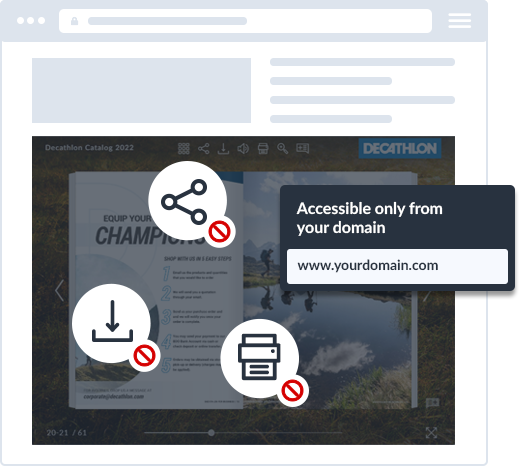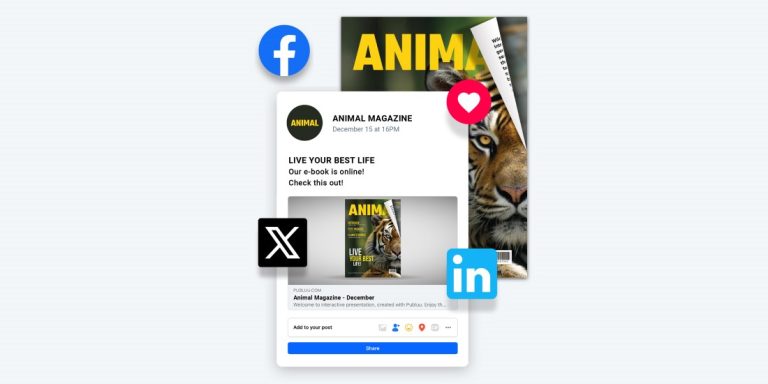How to Sell Ebooks: Guide With Tips and Strategies
Do you have a great idea for a book but aren’t sure how to make it profitable? Whether you dream of writing a bestselling novel or sharing your knowledge in a how-to guide, selling eBooks with our flipbook maker is the ideal solution!
Publuu's ebook example
View more online flipbook examples
This guide will tell you everything you need to know about creating, publishing, and marketing your eBook - from choosing the right theme and format to selecting the best publishing platform and implementing effective marketing strategies.
Creating an eBook that people want to buy
If you're thinking about writing an eBook, you must start with something unique that isn't already on the market. Any product, whether a book or a doughnut in a café, must offer added value to your customers. Your audience needs to see clear advantages and a reason to choose your book. Think about it: does the world need yet another vegan cookbook? What can you offer that hasn’t been done before?
First, think over your project and work out what your readers care about and need. Look at the challenges they face, and come up with some practical solutions in your eBook. Put your ideas into a logical order and create a table of contents. This will give you a basic outline; you can add more details later.
💡 For more information about your target audience, visit this page.
Make a plan and write!
When you have the ideas ready… well, sit down and write them down! Still, you can't create a book without hard work. Decide how many hours you want to spend writing, estimate your daily word count based on your available time, and try to write something every day. Focus on completing a first draft so that you have something out!
Once you have a version that conveys what you want to say, start the real work - revising and editing. You can hire a professional editor using portals like Fiverr or ask your colleagues for help. Reserve time to thoroughly revise and edit the content of your eBook, which can sometimes be more time-consuming than writing it!
Prepare your eBook as an online flipbook
Once you’ve completed your book, prepare it as a PDF using programs such as InDesign, Affinity, or the free Scribus. You can either send the PDF for printing or publish it online with Publuu like one of our subscribers.
Publuu's online flipbook example
View more online flipbook examples
Why choose Publuu flipbooks 👇
- Elegant design. Your books will have a professional look that draws attention.
- Interactive hotspots. These not only help you navigate your book but also allow you to embed additional, engaging material.
- Integration with animation. Animated GIFs, slideshows, or even YouTube videos can enhance any content, from entertainment to practical instruction.
- Easy sharing. Share your eBooks via social media, embed them on your website or in emails, or create a virtual bookshelf accessible for customers:

How to sell eBooks online
1. Research the market first
OK, you might have a great idea for your novel, but if you want to make money from it, it's important to consider the costs and time involved before you actually start writing. For instance, think about how many hours you're willing to spend and how similar books to yours are selling.
Take a look at similar eBooks and examine their sales rankings, customer reviews, and prices. You might not always have access to sales figures, but look for the data they provide. For example, you can research what a Kindle bestseller actually means and how many copies they sell.

Think about who you're writing for, what they like, and how much they’re likely to spend on digital content. For instance, if you're writing a cookbook for vegan bakers, look at the sales of similar cookbooks on Amazon to see if there's demand for that particular niche. Of course, it might be that there's no interest because there's very little supply - you may be able to be the first!
2. Pick your topic
The success of your eBook depends on choosing a topic you are passionate about and know well. As the saying goes, "Write what you know." This will make the writing process more enjoyable and your content will be authentic and valuable. For instance, if you don't know graphic design, don't write about it - you won’t even understand the guides.
Clearly define the scope of your eBook. Will it be a comprehensive guide, a concise manual, or a collection of short stories? Instead of a general book on "healthy cooking," focus on something specific, like "30-minute vegan meals for busy professionals."
💡 Keep your audience in mind - overworked businesspeople, for example, might prefer a bullet-pointed guide over long essays.
3. Make your plans and start writing
Before you start working on your book, you need to have a plan. Start by outlining the chapters, sections, and main conclusions of your eBook. You should create at least a basic framework.
Create a schedule and follow it. It helps to break down the writing process into smaller, manageable tasks to avoid getting overwhelmed. For instance, if your eBook has five chapters, plan to write one chapter a week. If you’re not creating fiction, visit the NaNoWriMo site for inspiration on how to plan and structure your book.
4. Design your eBook
How your eBook looks is just as important as what it says. High-quality images, graphics, and clear formatting can improve readability and interest readers. With Publuu, you can present your eBook with a realistic page-turning effect, high-resolution photos, and a background that makes it a pleasure to read.
Choose your book format carefully. If you want to sell eBooks to Kindle readers, choose EPUB. If your eBook relies mainly on graphics, such as in the case of comics or science sections, PDF may be a better option. Publuu lets you easily convert your eBook into interactive flipbooks that anyone can read online.

Also, select an easy-to-read font and font size. Use appropriate spacing, headings, and subheadings to improve navigation. Consider using a professional eBook formatting service or software to provide a polished and professional look.
5. Choose your store
Create an online store on platforms such as Amazon KDP, Sellfy, or embed your flipbooks on your own website using Publuu. We'll discuss these platforms in more detail in the next section, but it’s important to have an effective way to sell your eBooks and market them well. Tailor your store to reflect your brand and ensure a smooth, secure payment process.
6. Calculate your price
Once you've got your offer and shop ready, it's time to think about the price. Look at what your competitors are offering and consider the value you’re providing to your readers. For example, a book written by a team of professionals will be more expensive than one written and edited by yourself.
You can also count how many hours you spent preparing the book, but your hourly rate will probably be quite low at first. At first, you may be working below typical wages - don't get discouraged! The beauty of eBooks is that they keep earning income while you're busy writing more books.

Don't forget that readers need to be able to afford what you're selling. Books like guides or short articles are often bought, but something like a dictionary or graphic novel might be a more exclusive choice, and readers may pay more for them.
Platforms for selling eBooks
There are many opportunities for both self-publishing authors and professional publishers. Most of these platforms publish eBooks in EPUB or, less commonly, in PDF format.
Amazon Kindle Direct Publishing
KDP is one of the biggest names in the eBook world. Professional publishers often want their books released on Kindle, but KDP gives you a chance to self-publish your content. You'll be able to get a good portion (up to 70%) of the money people pay for your book, and millions of people visit Amazon every month.
But there's a catch: if you choose their KDP Select program, you can't sell your book anywhere else for 3 months. Your content is exclusive, which may be helpful for beginners, but you may miss out on the chance to make money on other platforms.
Apple Books
Most iPhones and iPads already have this app installed, so there's a good chance people will be searching for books using this online store. If you're a Mac user, you can even export your book using Apple Pages and then publish it in the Apple Store with one click! Like Amazon, they also pay authors a fair portion (70%) of sales.
Google Play Books
The Google Play Books app is pre-installed on most Android devices, so you can reach a huge audience. And since it's Google, your book may even appear higher in search results! Similar to others, they provide a 70% royalty rate on most sales.
Kobo
This platform collaborates with many bookstores, including Walmart and other retailers worldwide, and also offers its line of Kobo eReaders. They have an app as well, so readers can find your work in many ways. Kobo pays authors either 70% or 45%, depending on the price of the book.
Barnes & Noble Press
B&N Press is another well-known brand with a long history in the book business. Like Amazon, they offer their own Nook reader, and you can self-publish your eBook here and reach millions of readers online and in their physical stores, particularly in the US. They provide a straightforward royalty rate of 70%.
If you'd like to find options beyond the stores mentioned above, we present 👇 below other options, such as subscription services:
Publuu
Publuu is perfect for self-publishing if you want full control and flexibility. You can securely sell your flipbooks by adding them to your website with embedded protection. You can also share them directly with your readers via email. This way, you manage the entire distribution process.

Publuu also makes it easy to share your books across any device and simplifies your publishing workflow. From publishing and marketing to building an engaged audience, our platform has all the tools you need to succeed.
Kobo Plus
Kobo Plus has been called the "Netflix for books." For a monthly fee, you can read as many books as you want. If you choose to publish your book through Kobo Plus, you can earn royalties based on how many people read it (around 60%).
Storytel
Storytel is similar to Kobo Plus. If you're based in the EU, this Scandinavian company might be a good choice. Through a subscription, it offers access to a huge library of eBooks and audiobooks for a monthly fee. Authors get 50% of the revenue through a service called PublishDrive.
Sellfy
This platform lets you set up your own online store specifically for selling eBooks. You can customize the look of the store, set your own prices and even use their marketing tools to promote your book. They offer a variety of plans starting at $19 per month.
Tips and marketing strategies for eBooks
1. Build a landing page
Prepare a selling page for your eBook - whether a website or a profile on social media. For example, if you want to create a book about architecture, the page will showcase visuals, add compelling descriptions, and ideas. The funnel should be easy: the viewers see ads, they go to your website or landing page, and then they make a purchase. They can buy an eBook from an online store or directly from you.
You can also use Publuu to create a catalog of what you have to offer. Make sure that your landing page is SEO-friendly, using good design and proper keywords - all of these can help your marketing strategy and can be fully leveraged thanks to flipbooks, which are hosted on our site and are indexed by Google.
2. Grow your email list
To market your book well, you should have a list of people willing to buy it. Research confirms that if you send outreach emails to people who are interested, you are much more likely to sell your product!
For example, offer a demo version as part of your email newsletter. If you're writing a book on illusionist tricks, you could provide a free PDF guide titled "5 simple tricks for beginners" in exchange for email sign-ups.
💡 You can use Publuu to create a newsletter or embed a demo flipbook directly in your emails.
If you have a company account on TikTok, Instagram, or Facebook - great! Use it to share previews, quotes or screenshots. Show off your book cover before the release to create a sense of anticipation. A great way to market your eBook is by counting down to launch day with engaging posts – introduce your characters or share insights about what readers can find inside.

Post videos on TikTok showing the exercises or examples and emphasize that "you'll find more details in the book." Show off your tools and explain how you created the book to generate interest. Another great way to use social media is through competitions, games, and giveaways.
For example, you could offer a free copy of your eBook to one lucky viewer who shares a particular post and tags three friends, or offer a reward for creative readers for costumes, hashtags, or anything that could go viral.
4. Repurpose content
If you wrote a book about the top 100 Marvel comic book characters, why not repurpose that knowledge to create a list of the most interesting MCU movie characters? You could also reuse your book's contents as teasers. For example, you could use one chapter as a blog post, create an infographic based on the book, or host a live Q&A session. All of these strategies will help you use the knowledge you've gathered and promote it online!
5. Build anticipation for the launch
There's nothing like slowly building excitement before the final release! If you already have a target audience, try to get them excited about the launch. Create a dedicated pre-launch landing page and describe exclusive pre-premiere bonuses, such as a reduced price or an extra video tutorial. It works for books as well as for video games!
In your newsletter, you can also share sneak peeks of the book’s interior, exclusive interviews with the author and illustrator, or feedback from beta readers. Encourage early purchases with a special discount available only during the pre-release period.
6. Rely on reviews
Today, one of the best forms of quality assurance is social proof. Users are more likely to trust other people and be influenced by feedback and reviews. Therefore, it makes sense to encourage readers to leave a review. Include a call to action in the eBook and on your website, asking readers to leave reviews on Amazon, Goodreads, and other relevant platforms.
Always remember to respond to reviews. Thank reviewers for their feedback and address any concerns or questions. Doing so will also help your book's image!
7. Appear wherever you can
Generate hype simply by being a guest anywhere you can. Look for opportunities to be interviewed on podcasts or YouTube channels related to the subject of your book. For example, if you know a history podcaster on social media, ask if they would be willing to promote your work. Even more established podcasters may be curious - they don't need to schedule an episode of a new podcast.
8. Work with influencers
Connect with popular bloggers, YouTubers, or Instagram influencers who specialize in areas related to your book. For instance, if you write about crocheting, reach out to arts and crafts influencers who know their stuff and offer them a free copy of your eBook in exchange for an honest review or social media promotion.

9. Take advantage of paid advertising
Use platforms like Facebook Ads and Instagram Ads to reach specific demographics. For example, if you're writing about the history of the Civil War, you might target well-educated, middle-aged men. Paid advertising can help display your book on their feeds. Make sure to include relevant keywords and hashtags in your ads.
10. Keep in constant contact with the customer
Respond quickly to inquiries and be as professional as possible. Respond to emails, social media queries, or comments below the eBook. Offer compensation to those who are unhappy, such as discount vouchers.
Benefits of selling eBooks
There are many benefits of selling eBooks, whether you use a platform like KDP or sell on your own. Publishing with Publuu provides all of these:
✔️ Higher profits. When you sell directly, you bypass the commissions typically taken by platforms like Amazon or other distributors. This means significantly higher profit margins for each sale.
✔️ Pricing flexibility. You have full control over your pricing. You can experiment with different price points, offer discounts to your newsletter subscribers, or even limit access after a specific period.
✔️ Marketing control. You have complete autonomy over your marketing efforts. You can sell Publuu flipbooks or use them as your marketing materials and tailor them directly to your target audience.
✔️ Ease of access. Readers can access your content with a simple click on any device they prefer, as flipbooks are designed to work smoothly everywhere.
✔️ Direct customer relationships. By selling directly, you get valuable customer data, such as email addresses. With Publuu features, you can build an email list, and inform readers about future releases or promotions.
✔️ Analytics. You gain valuable insights into your sales performance. Our robust analytics lets you learn where your customers are coming from, and which pages are the most often viewed.
Conclusion
If you want to make money from your eBooks, you need to start with a good plan. This means choosing a good topic and understanding your readers. Success in selling books isn’t just about writing - it's about building a complete ecosystem around your work. This includes having a strong online presence, engaging your audience through email marketing and social media, and raising awareness of your product.
You won't be successful without choosing the right way to publish and market your book. Platforms like Publuu can help you promote your books. However, the most important thing is to create high-quality content that your readers will enjoy.
You may be also interested in:
How to Sell an Online Course? Quick Guide
How to Sell a PDF – The Complete Guide